Assessments: General Remarks
Submission
Please follow these templates consistently:
Download the template as follows:  and edit them accordingly.
and edit them accordingly.
You will submit through Canvas a .html file obtained from a Python .ipynb Jupyter Notebook file. To do so, in your .ipynb file, follow these steps: File –> Save and Export as.. –> HTML. Prior to this step, the notebook needs to be rendered (i.e. all the cells should be executed).
Other file formats will not be accepted.
Important for Assignment II, before exporting your .ipynb to a .html file: follow the steps described in the template to include an interactive dashboard in the static html that will be sumbitted as your assignment. This is to guarantee that your dashboard works in the submission file. You are responsible of your dashboard working as expected.
Marking Criteria
This course follows the standard marking criteria (the general ones and those relating to GIS assignments in particular) set by the School of Environmental Sciences. Please make sure to check the student handbook and familiarise with them. In addition to these generic criteria, the following specific criteria will be used in cases where computer code is part of the work being assessed:
| Mark Range | Description | Narrative | Map(s) and/or Dashboard Design | Technical Skills | Interactive Map/Dashboard Fully Working (required) | API Call (required) (A1) |
|---|---|---|---|---|---|---|
| 0-15 | Minimal or no effort, incomplete, or no functionality. | Limited or unclear problem and justification. | Minimal effort, lacking justification for design choices. | Code does not run, no documentation provided. | No | No |
| 16-39 | Basic functionality with significant issues or missing components. | Problem and justification are somewhat unclear or incomplete. | Design choices lack depth or clear connection to the dashboard’s aim. | Code does not run or produces incorrect output. Some documentation is provided, but it lacks clarity or detail. | Partially | No |
| 40-49 | Meets minimum requirements with some functionality and basic clarity. | Problem and justification are clear but not well-integrated into the overall framework. | Basic design choices are made, and some connection to the interactive map’s (A1) or dashboard’s aim (A2) is present, but the design lacks refinement. | Code runs and produces the expected output. Documentation is present but lacks depth or proper formatting. | Partially | No |
| 50-59 | Meets expectations with functional output and clear structure. | Clear problem identification and justification, but limited integration with other components. | Reasonable design choices are made with some level of thought towards usability and presentation. | Code runs and produces the expected output. Extensive documentation explaining the logic is provided. | Partially | Yes |
| 60-69 | Good overall quality with functional and thoughtful design. | Problem and justification are clear, and some integration with the overall framework is evident. | Thoughtful design choices are made and connected to the interactive map’s (A1) or dashboard’s aim (A2), with some justification for interactivity and widgets (A2). | Code runs and produces the expected output. Extensive, properly formatted documentation is provided, showing a good understanding of concepts. | Yes | Yes |
| 70-79 | High-quality work with clear evidence of advanced skills and integration of components. | Problem and justification are clear and well-integrated with all components of the assignment, creating a cohesive narrative. | Excellent design choices are made, with strong connections to the interactive map’s (A1) or dashboard’s aim (A2) and well-justified interactivity (A1 and A2) and widgets (A2). | Code runs and produces the expected output. Evidence of advanced skills is demonstrated in the code design. | Yes | Yes |
| 80-100 | Exceptional work with innovative contributions and flawless execution. | Problem and justification are excellently presented and fully integrated into a cohesive, professional-quality narrative. | Outstanding design choices with creative elements, advanced interactivity, and exceptional attention to detail in connecting the components to interactive map (A1) or the dashboard (A2). | Code runs and produces the expected output. Extensive, properly formatted documentation is provided, including novel contributions (e.g., algorithm optimizations, novel methods to improve functionality). | Yes | Yes |
DOs and DONTs
- Do not include “temporary” maps unless you really need to specifically show something to your reader.
- Do not include maps that have no actual differences, apart from few things (e.g. you changed the zoom level).
- Mix the accompanying text, in markdown cells, with the code.
- Do not include all the text at the beginning.
- Provide some theoretical context and motivation to your topic.
- Present 2 or 3 NICE maps and the final interactive map (Assignment I) and the one included in your dashboard (Assignment II)